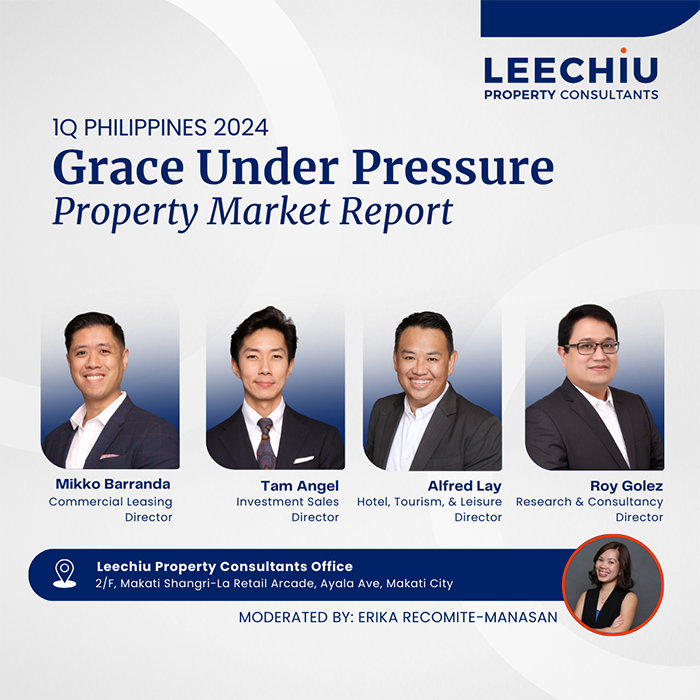As we step into the second quarter of 2024, the landscape of Philippine real estate continues to shift. Leechiu Property Consultants shed light on these evolving trends in their ‘Grace Under Pressure’ Q1 report last April 16, 2024, revealing how areas outside the National Capital Region (NCR) are finding their stride.
In the dynamic landscape of Philippine real estate, the first quarter of 2024 has brought about a perceptible shift, particularly within Metro Manila. In a marked departure from previous years, the region has seen a cooldown in its bustling condominium market. Detailed analysis reveals that new project launches went down by 38%, and unit sales dipped by 35% compared to the latter part of the previous year. Despite these figures suggesting a downturn, the narrative is far more complex. The Bangko Sentral ng Pilipinas (BSP) reports a 10% year-over-year surge in residential real estate loans—a beacon of underlying resilience and potential within the market.
Metro Manila’s property landscape, once defined by its soaring high-rises and frenetic pace of development, is evolving. Where once the skyline was continually being redefined by new condominiums, now we observe a distinct change in the winds of urban development. The capital’s land, scarce and expensive, has ushered in a new era of expansive, community-focused living spaces beyond the city’s traditional borders. These integrated townships offer not just homes, but lifestyles—a significant departure from the congested vertical living spaces of yesteryear. They are redefining the paradigm of residential living with their emphasis on more space, greater affordability, and the holistic allure of a community-centric existence.

Amidst global uncertainties and local economic challenges, the Philippines’ property sector remains undaunted. Geopolitical tensions and sustained high policy rates have not deterred the market’s enthusiasm. Developers are recalibrating their strategies with agility, recognizing the enduring demand for residential spaces. They are recalibrating with a keen focus on affordability and are aligning their offerings with the nuanced needs of buyers to ensure market equilibrium and vibrancy.
The trajectory ahead for the residential market is one of cautious optimism. With the sector on a steady path of recovery and infrastructure projects continuously unfolding, the outlook is promising. Developers are at the ready, planning a spectrum of new projects, both vertical and horizontal, with a readiness to pivot their strategies in response to the market’s pulse. The aim is to sustain healthy sales levels while mitigating the risk of project fallouts.
Indeed, the market performance in 2023 surpassed expectations, but this year presents a scenario that requires developers to fine-tune their approaches further. Despite a slowdown in activity within Metro Manila, the momentum of projects outside the National Capital Region has contributed significantly to an upbeat market sentiment.
The BSP’s data compilation underscores a growing trend: an uptick in Residential Real Estate Loans (RRELs) over the past year, with projections indicating that this will persist into the current quarter. There’s a palpable divide emerging in the pattern of loans granted within NCR and the outlying areas—a trend that began amid the pandemic. In 2023, an impressive 66% of RRELs catered to housing units in the regions beyond Metro Manila, showcasing a steadfast demand for migration.
For prospective homeowners, the past scenario of a Metro Manila-centric residential offering presented a conundrum—limited choices in an environment of scarce vacant land and exorbitant costs. This dilemma has been alleviated by the advent of integrated township developments supported by burgeoning infrastructure projects. Such developments have permitted low-density horizontal projects, such as single-family homes and townhouses, to thrive. This has not only catered to the desire for more spacious living environments but has also granted developers the flexibility to invest funds without the hefty capital requirements of high-rise constructions.
These burgeoning townships proffer a more affordable and spacious living solution, with the added convenience of city amenities within a larger, integrated community. Infrastructural advancements have bridged connectivity gaps, weaving these townships into the fabric of major cities and other projects, and fostering a network of liveable, sustainable communities.
The residential property sector’s demand drivers remain positive, notwithstanding the risks posed by geopolitical strife and the economy’s macro-conditions. Developers are proactively matching the evolving requirements of buyers, offering new projects outside the confines of Metro Manila while adjusting payment terms to minimize the risk of market fallout.
Looking forward, the residential market is set for growth, underpinned by positive economic indicators and a commitment to geographically inclusive development. This growth is expected to be sustained by the proliferation of townships and strategic infrastructure initiatives.
Roy Golez, Director of Research and Consultancy, encapsulates the market sentiment with precision: “The fundamental factors that buoy residential market performance are infrastructure growth, affordability, convenience, and the dream of owning a home—with bigger space. These are facilitated by township developments outside Metro Manila.” His words serve as a reminder of the enduring aspirations driving the property market forward in the Philippines—a vision of expansive living and communal harmony.
In an era where the rules of real estate are being rewritten, it is the adaptability and foresight of developers, coupled with resilient market demand, that will define the future of Philippine housing. As we continue through 2024, the property market’s evolution is a testament to the industry’s capacity to not only withstand pressures but to emerge from them with innovative solutions for a changing populace.
Key Points from ‘Grace Under Pressure’
- Decentralization: A shift from the concentrated development in Metro Manila to sprawling townships elsewhere is unmistakable. With improved infrastructure catalyzing development, prices in these areas have seen robust growth.
- NCR’s Vertical Project Downturn: Demand and project launches for vertical residences in Metro Manila have dipped, with only four new projects this quarter.
- Double-Digit Growth in Upscale Condos: Capital values in Metro Manila’s high-end condos are climbing, a trend mirrored by prime villages.
- Loan Landscape: Residential real estate loans have surged by 10% from the previous year, with CALABARZON and NCR accounting for the majority.
